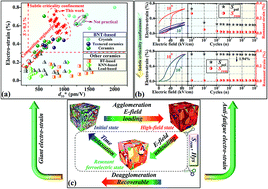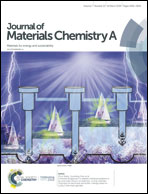Superior and anti-fatigue electro-strain in Bi0.5Na0.5TiO3-based polycrystalline relaxor ferroelectrics†
Abstract
For eco-friendly bismuth sodium titanate (Bi0.5Na0.5TiO3)-based materials, ultrahigh poling strain (Spol) is always accompanied with a sizable remnant strain (Srem), which severely restricts the cycling reliability of their superior electro-strain. Composition engineering is an effective way of eliminating Srem, but Spol will be sacrificed as well, leading to an overall inferior electro-strain. Here, by composition engineering and subtle criticality confinement, a giant recoverable electro-strain (S > 0.7%, realizing Srem modulation without Spol sacrifice) with reduced hysteresis is reported in BNT-based relaxor ferroelectrics, which can be kept at a high level (<2% variation) even after 105 fatigue cycles. As disclosed by the detailed electric field-dependent multi-scale analyses, the electro-strain behavior is tightly associated with the agglomeration and deagglomeration process of polar clusters. More efficient release of mechanical mismatch stress among interacting polar entities is suggested to facilitate the deagglomeration process of polar clusters, ensuring a faster restoration of the electric field-induced ferroelectric state when the electric field is removed, which is responsible for the reduced hysteresis and the excellent fatigue performance. These results indicate the significance of “subtle criticality confinement”, and the insight for the design of polycrystalline ceramics with giant and anti-fatigue electro-strain may be useful to develop a new generation of eco-friendly actuators.



 Please wait while we load your content...
Please wait while we load your content...